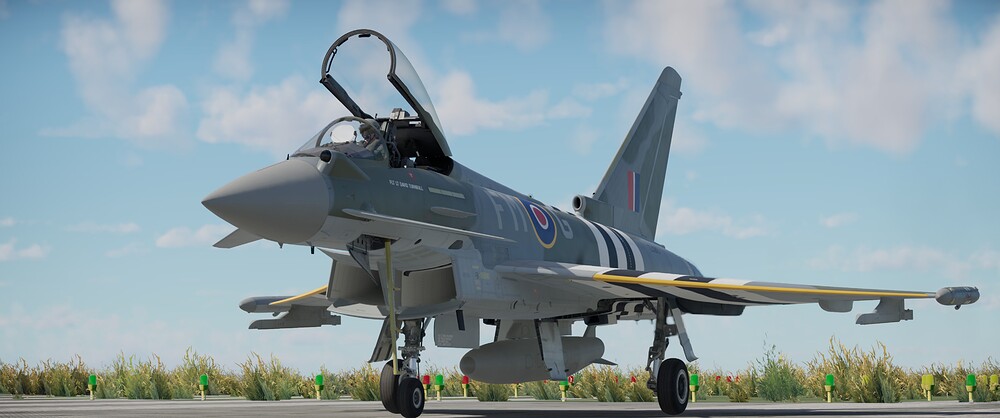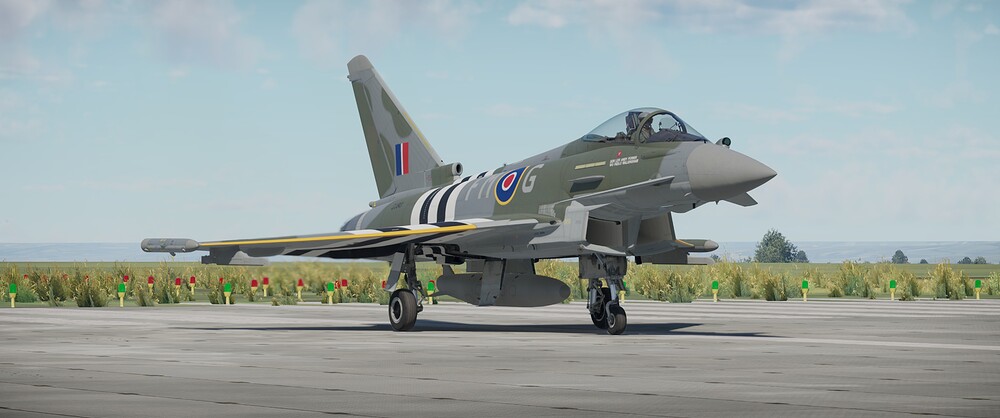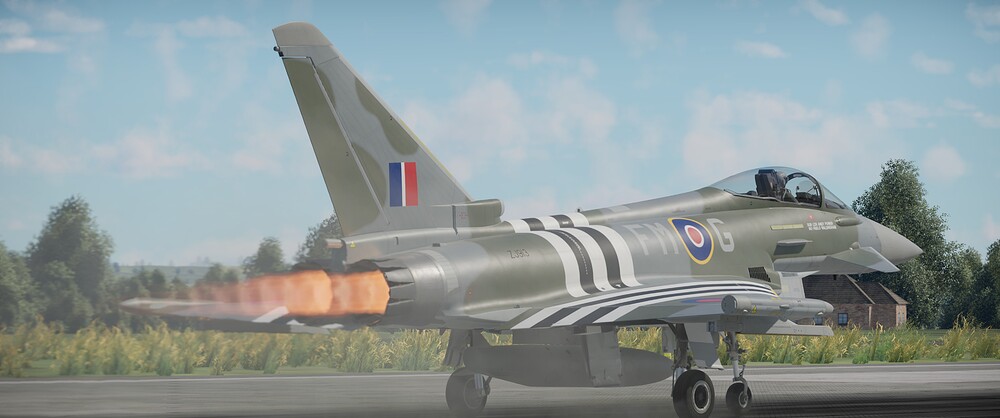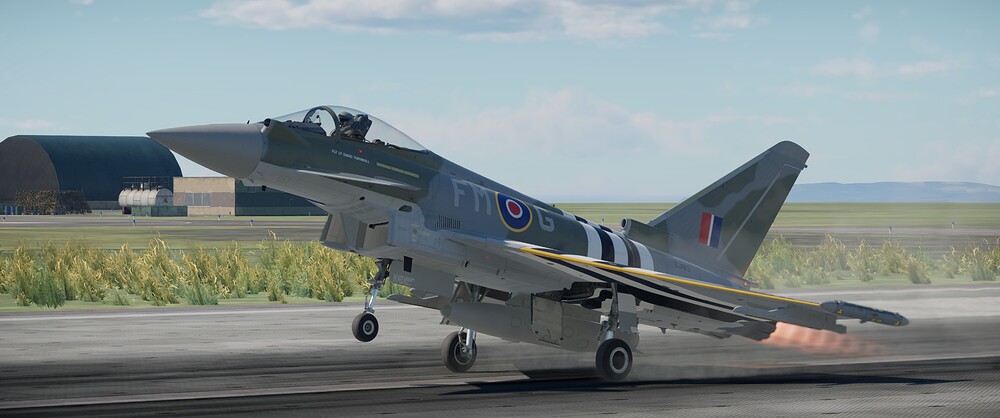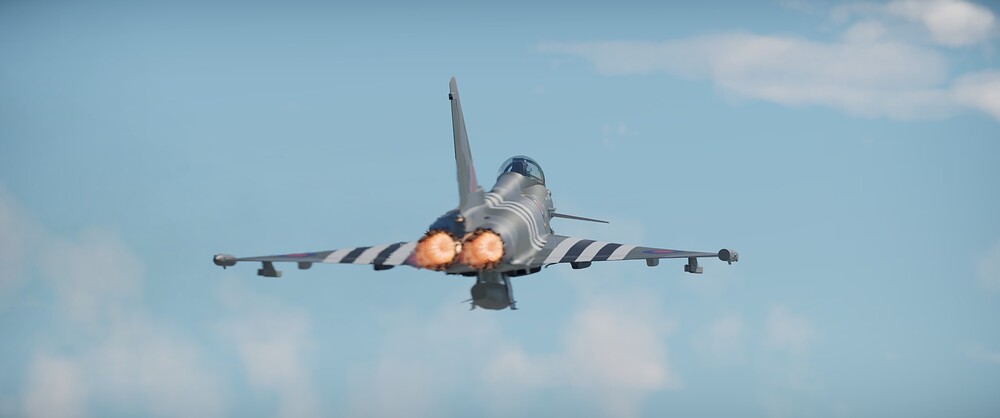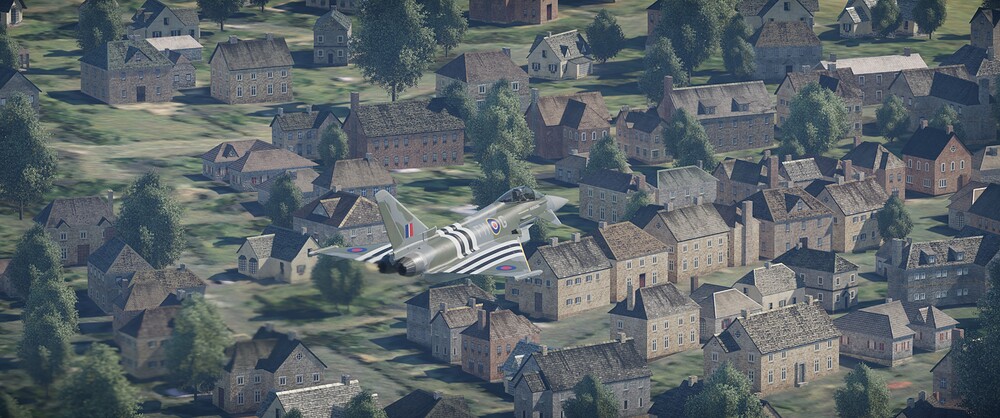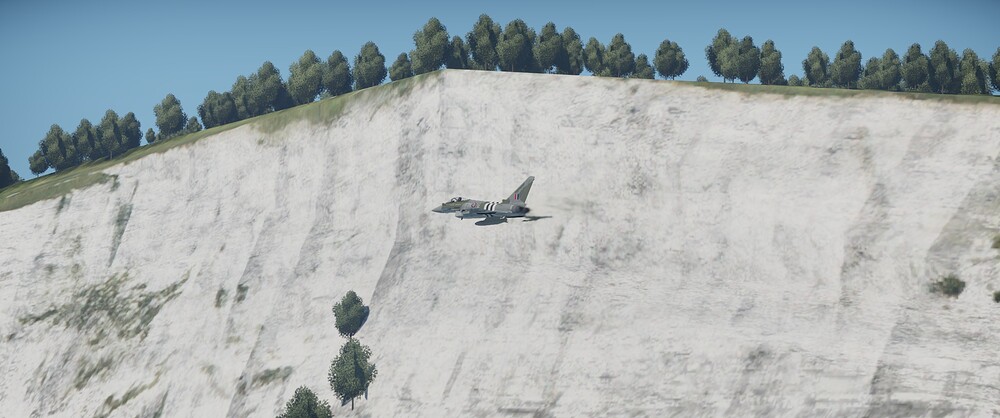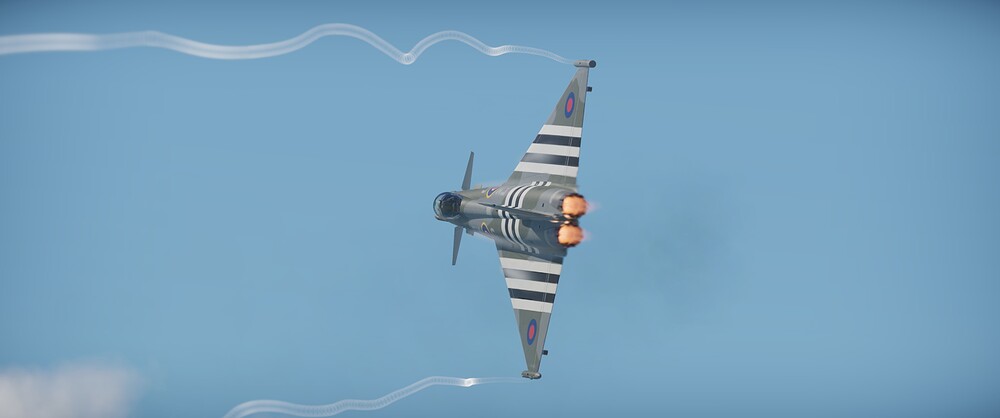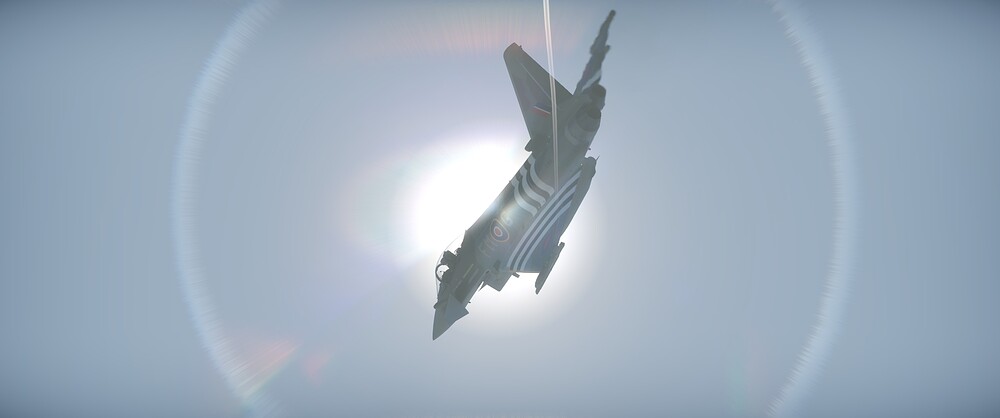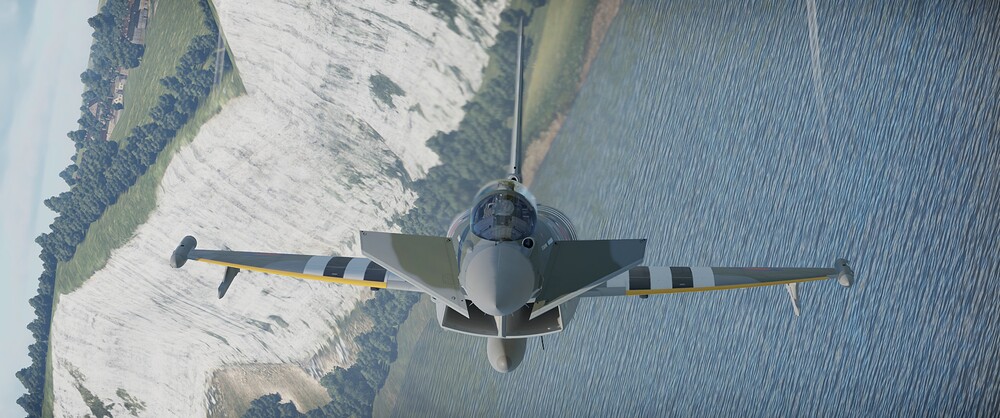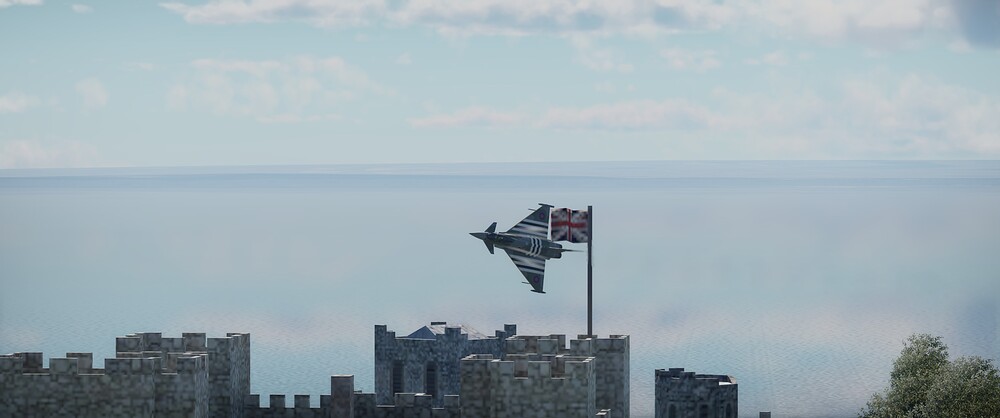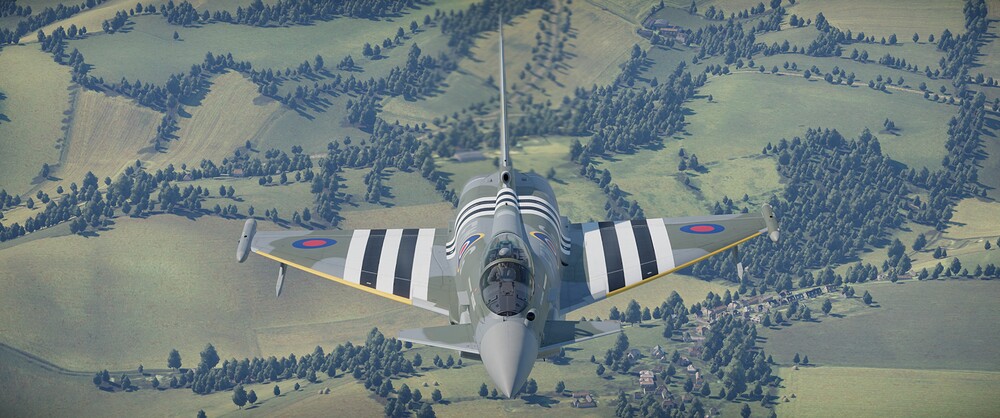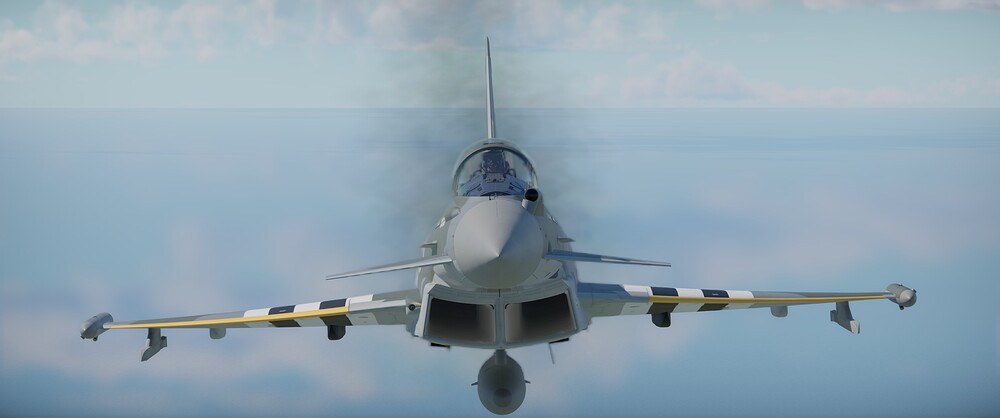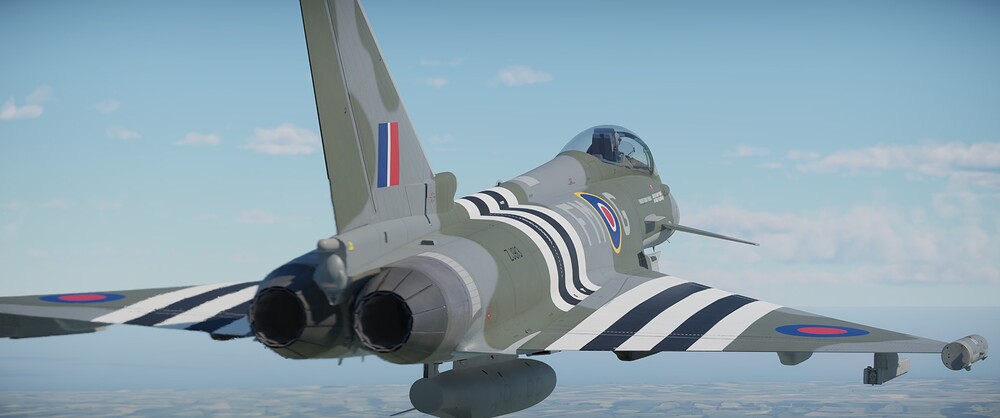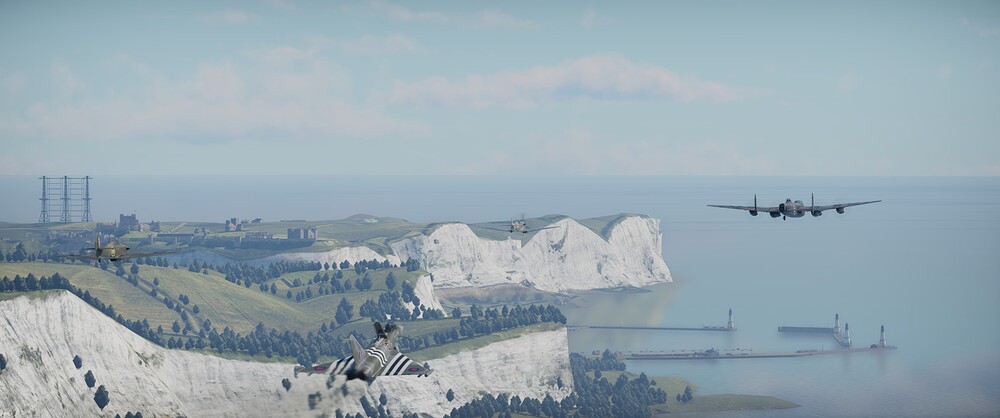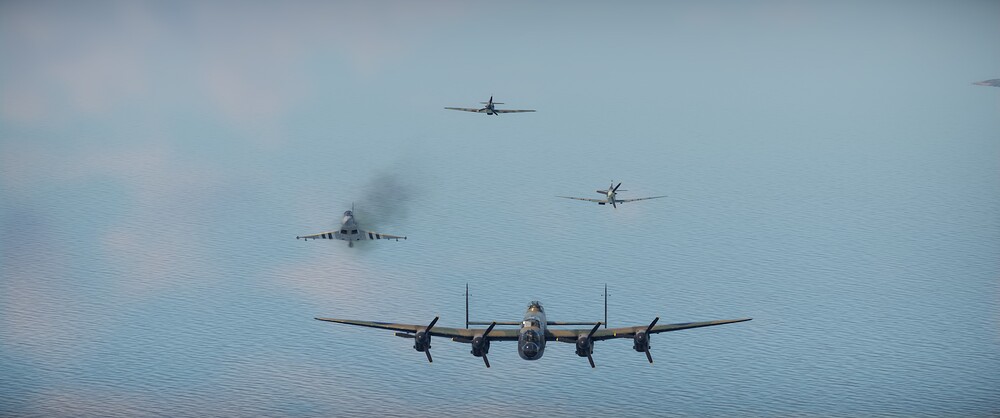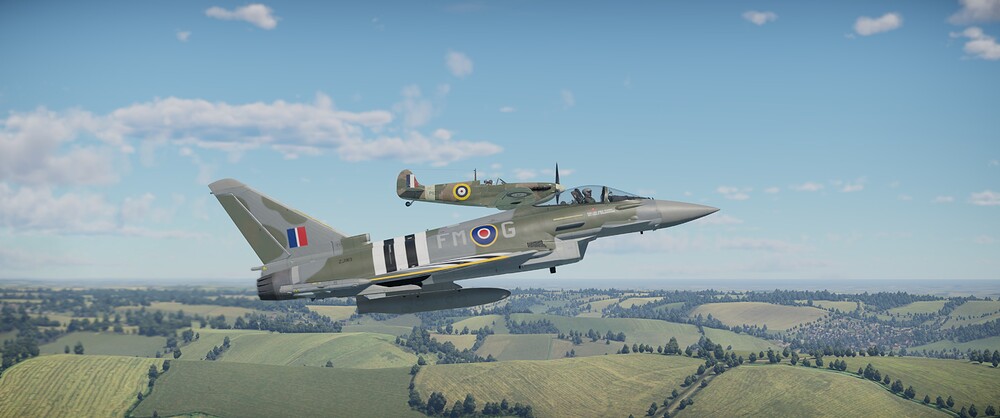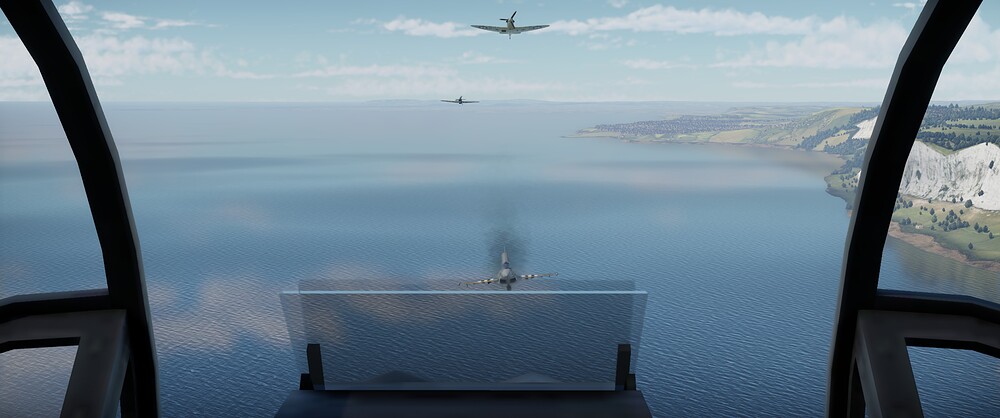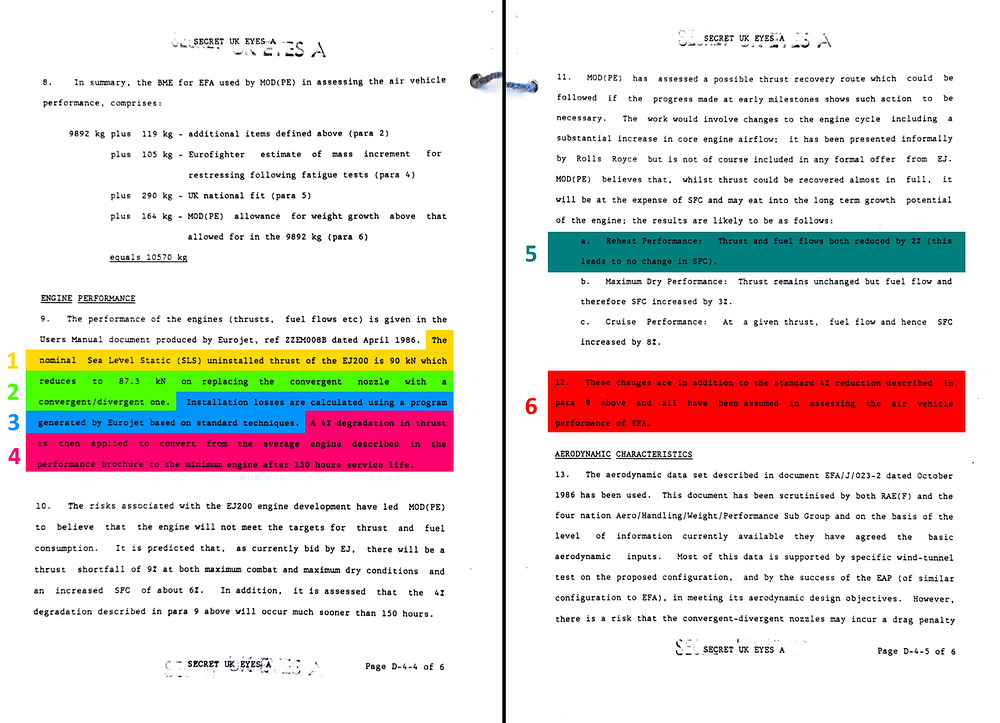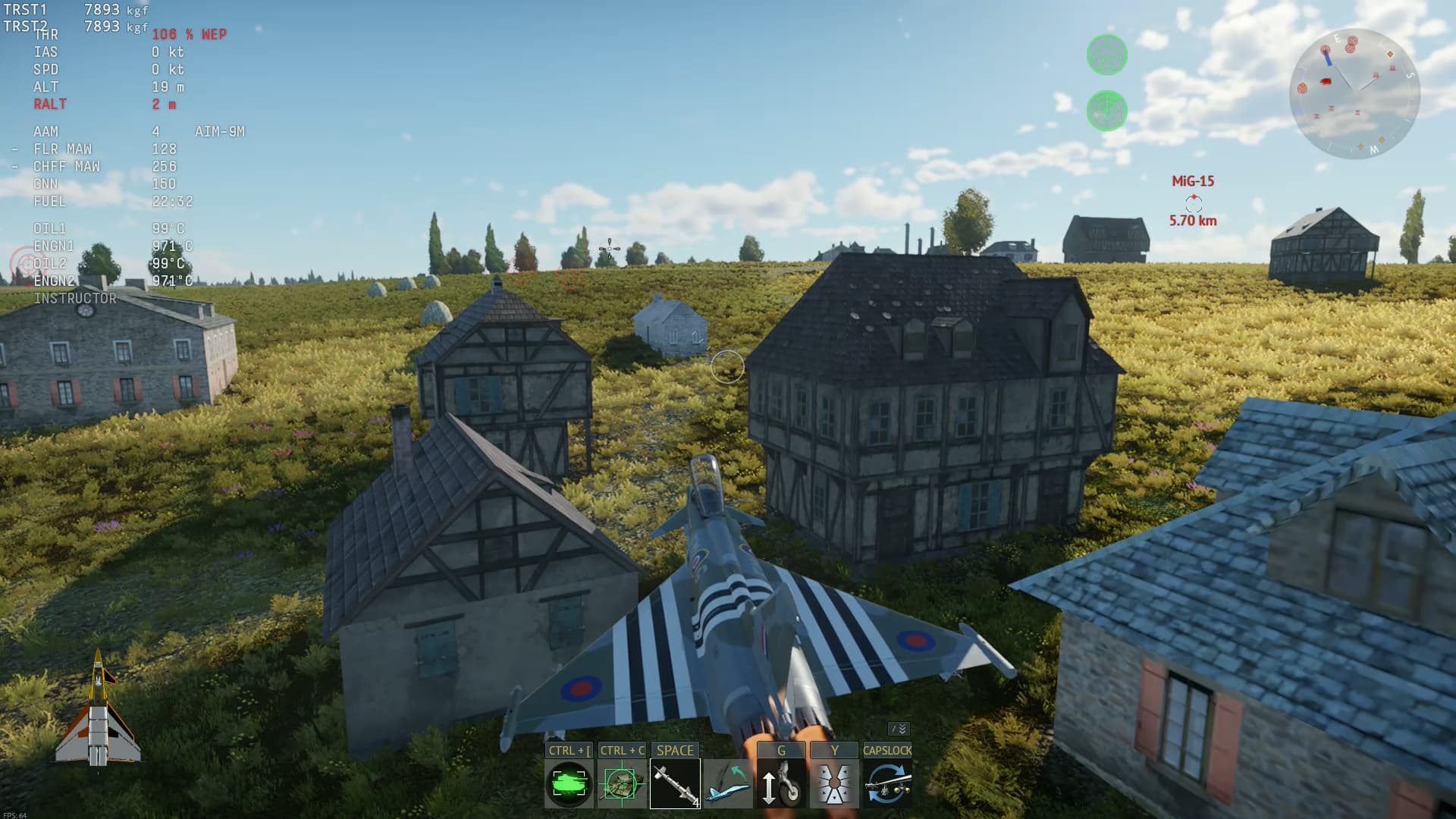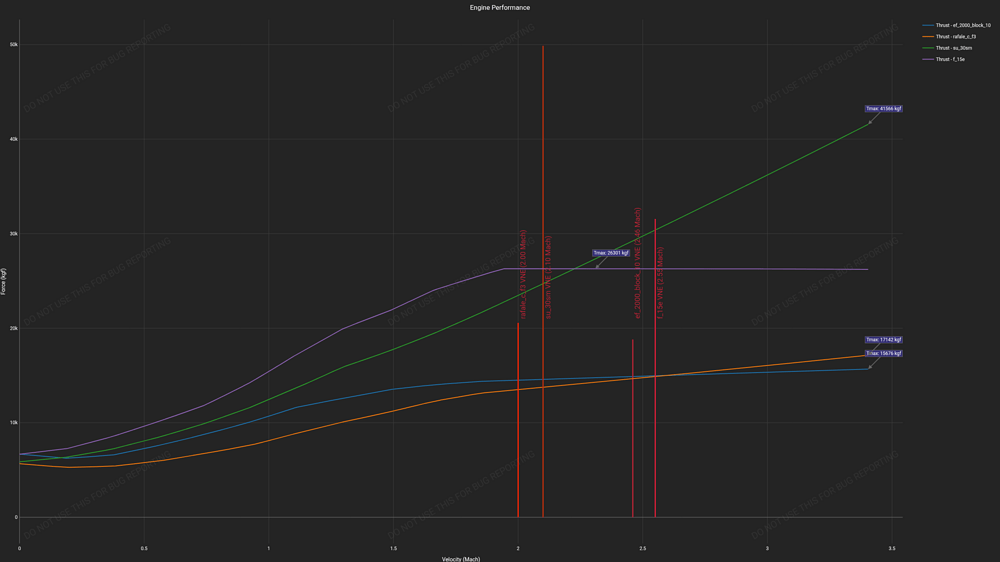I’m sure that potentially it could. But it could just as easily not be optimized for this and design changes could have been made to suit mass production and its service life. At the end of the day anyone can make wild guesses on how the values changed after this document was made, but those are not reasonable ways of assessing the aircraft’s performance.
Watch accel | Streamable 63s from 0.9-1.6 @ 11,000m on 107% THR compared to the estimated 80.4s. The EFA MOD PE is a 27% increase in acceleration time.
If you go off of the requirement vs the aircraft in afterburner the difference is bigger. Neither of these values resemble the in-game performance.
Iirc 106% is closest for accurate thrust. Also 2 amraam instead of the extra 2 9M’s, or is that just the UI.
The closest value from the thrust reduction given in the document is 107%, and I cycle through my weapons groups halfway through the video…
You are comparing the aircraft in game to the 1987 performance estimates, it is a known fact that various refinements were made to the aerodynamic and engine design after 1987 in order to improve the aircraft’s performance. In addition it would appear that there is good reason to believe the finished Eurofighter design met the flight performance requirements. A more accurate approach would likely therefore be to compare the in game vehicle to the STR requirements (which based on the evidence were likely met) rather than the 1987 predicted values which are known to be outdated. And if you do that you will see that it is with a couple of exceptions it is either correct or under performing in game.
The 1987 estimates used an empty mass of 10,570 kg and 4,300 kg of fuel for a total empty mass + fuel of 14,870 kg. The Eurofighter in game has an empty mass of 11,220 kg (no idea where Gaijin got that number from), so it requires 3,650 kg of fuel to have the same empty mass + fuel of 14,870 kg.
The 1987 estimates used a static thrust of 82,132 N (8,375 kgf) per engine, installation losses were then applied on top of that figure. We don’t know what the real installation losses were so we’ll just have to run with what Gaijin’s given us. The uninstalled thrust of the finished EJ200 is 90,000 N (9,177 kgf); in game the installed static thrust of each engine is 8,645 kgf giving a installation loss of about 5.8%. If we apply a 5.8% reduce to 8,375 kgf we get a thrust of 7,889 kgf stationary at sea level; the closest I could get to that in game is 106% throttle.
So as far as I can see the closest we can get to the conditions of the 1987 estimates in game are as follows. And as such I’ll use these for my testing:
- Fuel mass: 3,650 kg
- Throttle: 106%
- Loadout: 2 x AIM-9, 2 x AMRAAM, 150 rounds of ammo
The results are as follows:
| Condition | 1987 Estimated Time (s) | Time measured in game (s) | Difference |
|---|---|---|---|
| 200 KEAS to Mach 0.9 @ 6,096 m | 28.7 | 25.6 | 10.8% |
| Mach 0.9 to Mach 1.6 @ 11,000 m | 80.4 | 69.6 | 13.4% |
So I agree that compared to the 1987 estimates the Eurofighter is indeed over performing, but certainly not the sensationalised 30% and 45% you claim.
However especially regarding the 11,000 m results I would also consider a couple of other points:
- With the aircraft configured as above to match the 1987 estimates at Mach 1.6 @ 11,000 m the SEP (according to WTRTI) is less than the 1987 estimated value (fluctuating around 120-125 vs 137.1).
- With the aircraft configured as above to match the 1987 estimates the time from brake release to Mach 1.6 @ 11,000 m is worse than the 1987 estimates (160s vs 144s) if you follow a fairly typical RAF climb profile (constant speed 450 KIAS / Mach 0.9). Video
- At Mach 1.6 @ 11,000 m the sustained turn rate is within margin of error (5%) of the requirement.
- Gaijin have in the past stated that they do not adjust aircraft performance exactly near the tropopause
So it may be the case that the acceleration over-performing is a side effect of Gaijin trying to get the other performance figures to be about right in a region where the game engine limits the accuracy they can achieve.
You need to take your channel loss % from 86.3kN, the stationary thrust with the convergent divergent nozzles installed, as this penalty is also included in the PE. Using this number the correct thrust to test with is at 107%. Eurofighter Typhoon (UK versions) - Technical data and discussion (Part 1) - #7833 by piiot
If you use the correct power setting, it overperforms at all altitudes against this metric.
The SEP being marginally too low at end of the speed range (and in the tropopause) does not preclude it being too high in other regimes, essentially it accelerates too fast at low speed, but marginally too slow at high speed given its acceleration in-game.
You can meet the time to climb benchmark with time to spare if you climb faster than 0.9M, choosing a suboptimal climb profile used for noise abatement and to make efficient use of airspace makes no sense against this benchmark.
Its STR compared to the requirement is not relevant for anything other than the MIL thrust STR at 0.9M/1500m. It overperforms against any required STR at altitude regardless, its not specific to one point. When comparing STR to the PE, it only matches at 103% throttle, meaning that any “aerodynamic improvements” would have to remove 7-8kN of induced drag on the aircraft, which is not possible.
Reports have been made accepted and implemented for the EF2000 to have it gain supercruise performance at 11,000m, saying that they dont adjust performance in the tropopause is outright false.
You cannot simply hand wave the PE because it is from 1987 when there is simply no newer data to base anything off of, ESR-D is even older and is is unclear what the “contractual requirements” even are, its more than likely those are the “key requirements” as seen in the GAO, which do not include most of the ESR-D’s long list of point performance and other equipment specs. There are also other ways in which the EF never met the ESR-Ds strict requirements that arent outlined in GAO, which should go to show that using ESR-D is a bad metric.
Also I’m not sure if you understood 45% @11,000m /30% @ 6000m correctly, thats for the aircraft at 110% vs ESR-D figures for acceleration. Against the performance estimate the difference is smaller, but still consistent across the board. There isn’t a factual basis for the aircraft performing better than both the PE and ESR-D, the only way to justify this is with heavy amounts of guesses and assumptions.
Some screenshots of Moggy in-game
Also as a bonus I spent a stupid amount of time trying to re-create the Battle of Britain Memorial Flight in Mission Editor to fly with Moggy. (Spent around 6 hours trying to get the stupid AI to follow the waypoint, then a further 2 hours trying to get them to fly in a formation but that seems to have been a hard limit so I gave up on that part.)
Hi @Smin1080p_WT hope you’re doing well, as you mentioned a few days ago, I put together a good report with evidence and an explanation of the issue so the devs can take a look. Could you please have a look at it? Thanks!
https://community.gaijin.net/issues/p/warthunder/i/Bab8bHrFYN8n
Honestly, I think this is the problem of all HMD capable aircraft, Rafale also suffer from this, Gripen too, the only HMD I think that’s pretty reliable was unironically Soviet.
Well then, that way they fix the ones that fail. Since I fly the Eurofighter and we’re in the Eurofighter forum, I’ve only spoken about the Eurofighter.
nope
they arent working as well unless you are locking them with the IRST and the nswitch to radar
Ok, lets work through this together. I’ll even go the extra mile and colour code it.
| Step | Description | Thrust |
|---|---|---|
| 1 | Nominal uninstalled thrust is 90 kN | 90 kN / 9,177 kg |
| 2 | This reduces to 87.3 kN due to the choice of nozzle | 87.3 kN / 8,902 kgf |
| 3 | Thrust losses are applied (in our case 5.8%) | 82.2366 kN / 8,386 kgf |
| 4 | A 4% thrust reduction is applied | 78.947136 kN /8,050 kgf |
| 5 | A 2% thrust reduction is applied | 77.36819328 kN / 7,889 kgf |
| 6 | Final thrust | 7,889 kgf |
So the correct thrust to match the 1987 estimates is 7,889 kgf, just like I said…
Oh and would you look at that 106% throttle in game is almost exactly 7,889 kgf. It’s almost as if I know what I’m talking about…
I took at look at SquishFace’s last Eurofighter video and he uses a climb speed of Mach 1.1-1.15 to demonstrate the climb rate in game. So lets try that with the previously discussed fuel and thrust to match the estimate conditions. And the result is: it took 149 seconds; which * checks notes * is longer than the 144 s estimated in 1987.
I mentioned those as a hypothesis for why Gaijin might have allowed the acceleration to be somewhat over-performing in that condition. If it is possible for them to adjust the acceleration downwards a tad, without messing up the other known data points that are about right (or even underperforming) I don’t have a problem with that.
In both my super-cruise report and top speed report Gaijin’s response was that they could not make it match the numbers claimed in the sources while using sensible numbers in the FM. So to this day the top speed with and without afterburner is noticeably worse than claimed in the sources used for the reports. I never claimed Gaijin “don’t adjust performance in the tropopause” I pointed out that by their own admission (and as conveniently demonstrated by the Eurofighter reports you mentioned) they seem to have a hard time making aircraft perform accurately there , and so they are willing to accept larger deviations than they would in other areas of the flight envelope.
The MOD(PE) estimates assumed a number of EJ200 performance shortfalls which did not materialise in the finished engine, and the aerodynamic deign of the aircraft is known to have been changed after the MOD(PE) numbers were calculated.
The ESR-D document contains the performance requirements for the Eurofighter aircraft. As shown in the bug report people have found sources which strongly suggest the flight performance requirements specifically were met. It is therefore more reliable to base the aircraft off the design requirements (which the available evidence suggests were met) rather than the MOD(PE) numbers which are based on an aircraft with weaker engines and different aerodynamics to the finished aircraft.
So you chose to base your percentages off of the ESR-D requirements, despite knowing that the MOD(PE) estimates had the aircraft performing quite a bit better than the requirements? As I said sensationalised.
And you’ll notice that:
- At no point in the past have I publicly criticised your acceleration bug report (other than when you explicitly asked for comments today and I said your percentages didn’t add up)
- I stated in my reply “I agree that compared to the 1987 estimates the Eurofighter is indeed over performing”
- I have at no point said the acceleration should not be fixed if it is over-performing. I just raised a concern that an adjustment to acceleration should be crafted as to not mess up the other known data points in that area of the flight envelope, and observed that Gaijin may be avoiding tinkering with it due to the difficulty they appear to have with making aircraft accurate at that altitude.
No problem, just saying it, hopefully the dev would also look for others as well since this also everyone’s problem.
Well it’s based on my experience though, yeah I could be wrong.
Still not sure why people are just taking that response at face value. The EFT’s thrust curve in-game is pretty bad when compared to other jets at its BR.
It has much less thrust gain from speed than the F-15E and Su-30SM, and has similar thrust output to the Rafales M88-2’s despite having a much higher thrust irl (50/75kN vs 60/90kN) for example, and the curve flattens out at a lower speed as well:
There was an aerodynamics paper discussing the EFT’s inlet design capability to continue supplying required air to the engines at speed which showed the engines were more in the ballpark of the Su-27 (yes I know, now what i used here, has a similar curve to the Su-27 in-game) than that of contemporary american aircrafts at speed posted in this discussion thread as well (tho afaik, that didnt go anywhere).
Its pretty silly of gaijin to pretend they couldnt improve the thrust curve on the jet in a realistic manner when its one of the worse ones at its BR.
Gaijin just went “EFT designers suck at designing engines” and everyone just took them at face value without checking.
So I tried to explain this to you before, but I’ll try to go through it again. The channel losses as present in-game are not 5.8%. The convergent-divergent nozzle design lowers the thrust of the final EJ200, meaning that the channel losses come out to be smaller than 5.8%. This is just due to its inherent design, you are still just assuming that the final aircraft accomplished every design goal, and in reality it did not. Again, the only proof that specific point performance requirements were met is the GAO, vague statements made in reference to the requirements at various points in its development are not conclusive of anything.
The steps you used for weight and thrust are correct, you just applied the wrong channel loss.
We need to factor in the convergent-divergent nozzle in to find actual channel loss.
The least generous penalty would be the 2.7kN as given in the EFA MOD PE, and the most generous would be 0.9kN as given by ITP.
*It is important to note that we do not know the actual value they eventually came to, engine manufacturers really like rounding.
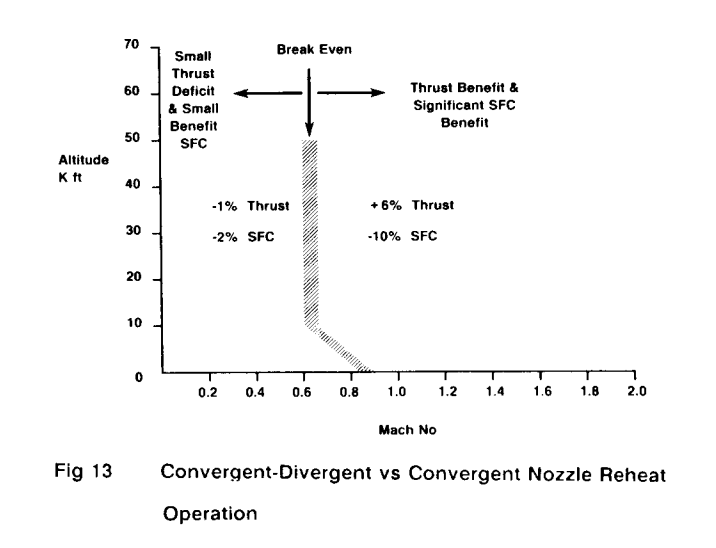
With a final thrust at 87.3kN/8902kgf CL would be 2.7%
With a final thrust at 89.1kN/9085kgf CL would be 4.8%
Spoiler
*worth also noting here that the 20,000lb used in every EJ200 brochure ever made is equiv to 9071kgf
Final installed MOD PE thrust:
Using the MOD PE value 8148kgf
Using the ITP value 7973kgf
107% THR is 16,002kgf, or 8001kgf, using 106% is simply too low for either estimate, and doesn’t give you a valid result for any measurement in-game. I’m not going to try to antagonize you back over it.
Using this power setting we get 138s of the predicted 144s for time to climb vid
As shown previously, 60s of 80.4s for 0.9M-1.6M @ 11000m
and 24s of 28s for 200kts-0.9M @ 6000m
And again, we need to lower the throttle to 103% (71kN) in order to match the STR, to put this into perspective it would be the equivalent of removing an entire He-162A @ 800kph of included drag, there comes a point where handwaving everything because a guy said there were “aerodynamic improvements” just doesn’t make sense.
This isn’t a 15kt max sep0 speed difference at 15,000m, its a clear trend across all speed ranges and altitudes. You would be hard pressed to find setpoints where it underperforms at all. As I said before you can’t reject the PE because it predicts aircraft performance that falls below the ESR-D, there is nothing to factually substantiate most of ESR-D even being used. As a kind of off topic example,
Spoiler
Requirements were “extremely demanding” in this case for example:

(little tangent but in a later revision they added a caveat for the afterburner itself being a visible signature which I find hilarious but back to the point)
Afterburner selection and deselection has a “visual signature” on the final aircraft
https://youtu.be/Jfk3BYOJON8?t=252
https://youtu.be/Jfk3BYOJON8?t=264
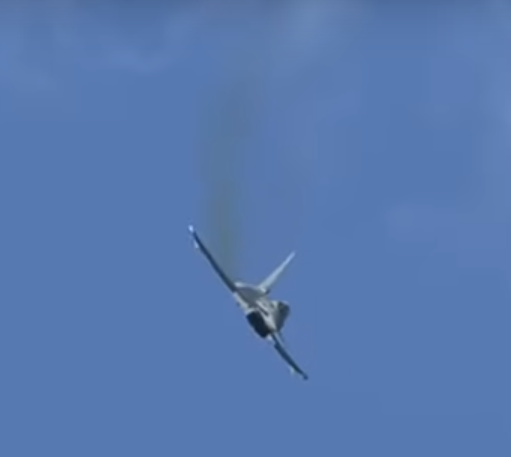

This is also included in the EJ200 brochure as you know, but you simply cannot assume that every requirement was met-especially when you see manufacturer claims that you can verify with your own eyes.
I hope this clears up some misconceptions, have a marvelous monday 😎
Gaijin tunes thrust along with drag to achieve point performance targets, channel loss and thrust curves are inconsistent across airframes. If thrust curves are available for an aircraft they’ll start with those and adjust drag accordingly, but if there isn’t or it isn’t clear the result is completely random.
I will say this, why do you think Typhoon after near 20 years service has never had any changes to it’s power plants and flight control system…You continually underestimate how good the EJ200 engine is mounted to Typhoon and how good the aircraft is in terms of kinematics. As quoted by pilots from all airforces. Even F-22 guys…It’s like being mad a Ferrari is fast…
You are also trying to change Typhoons performance…Which if it is unrealistic is fine. What you and many other fail to realise if you change Typhoons performance you then need to reduce the F-15, F-16, F-2, Su-27 all other Gen 4s etc.
Otherwise we end up with what Gaijin have done to the Rafale where it now loses to a slightly larger winged F-16, is that realistic to you?
Picking and chosing which jets you want rebalanced/changed will be a never ending struggle what we do not need is a complete overhaul of the how the game interperates modern fly by wire systems and thrust.
Gaijins specific statement on the issues were that the EFT could not be given the appropriate supercruise speed and top speed because it would require unrealistically high thrust or unrealistically low drag iirc. That isnt a statement saying that it doesnt fit their model, thats a statement saying they dont believe its possible. Its a similar stwtement to what they used to initially deny some Rafale buffs before they improved its thrust and lowered its drag anyways.
Also, the thrust curve being adjusted to have higher thrust outputs at higher speeds than it currently has should allow the aircraft to reach the relevant supercruise and top speed numbers while having minimal impact on performance numbers at other speeds.
No, this is in reference to the RB199, where selection and deselection of reheat would dump fuel and smoke out, making it plain clear to opposing pilots what the current state of the throttle was.
